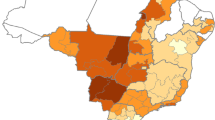Abstract
A cross-sectional study was carried out to determine the seroprevalence and risk factors associated with bovine respiratory syncytial virus (BRSV) infection in non-vaccinated dairy and dual-purpose cattle herds from Ecuador. A total of 2,367 serum samples from 346 herds were collected from June 2008 to February 2009. A questionnaire, which included variables related to cattle, health, management measures, and the environment, was filled out in each herd. Presence of antibodies against BRSV was analyzed using a commercial indirect ELISA test. A logistic regression model was used to determine risk factors associated with BRSV at herd level. The individual seroprevalence against BRSV in non-vaccinated herds in Ecuador was 80.48% [1,905/2,367; 95% confidence interval (CI) = 78.9–82.1]. The herd prevalence was 91.3% (316/346; 95% CI = 88.3–94.3), and the intra-herd prevalence ranged between 25% and 100% (mean, 90.47%). The logistic regression model showed that the existence of bordering cattle farms, the dual-purpose farms, and the altitude of the farm (more than 2,338 m above sea level) were risk factors associated with BRSV infection. This is the first study about BRSV prevalence in Ecuador. It shows the wide spread of the BRSV infection in the country. The risk factors found will help to design effective control strategies.
Similar content being viewed by others
References
Almeida, R.S., Spilki, F.R., Roehe, P.M., Arns, C.W., 2005. Detection of Brazilian bovine respiratory syncytial virus strain by a reverse transcriptase-nested-polymerase chain reaction in experimentally infected calves, Veterinary Microbiology, 105, 131–135.
Autio, T., Pohjanvirta, T., Holopainen, R., Rikula, U., Pentikäinen, J., Huovilainen, A., Rusanen, H., Soveri, T., Sihvonen, L., Pelkonen, S., 2007. Etiology of respiraty disease in non-vaccinated, non-medicated calves in rearing herds, Veterinary Microbiology, 119, 256–265.
Carbonero, A., Maldonado, A, Perea, A, García-Bocanegra, I, Borge, C, Torralbo, A., Arenas-Montes, A., Arenas-Casas, A., 2011. Risk Factors against Bovine Respiratory Disease in Suckling Calves from Argentina, Archivos de Zootecnia, 60, 41–51.
Contreras, A., Parra, J., 2000. Detección indirecta del virus respiratorio sincitial bovino (VRSB) en sueros provenientes de la sabana de Bogotá y zonas aledañas, Tesis Medico Veterinario, Universidad de la Salle, Santa Fe de Bogotá, Colombia.
Hägglund, S., Hjort, M., Graham, D.A., Öhagen, P., Törnquist, M., Alenius, S., 2007. A six-year study on respiratory viral infections in a bull testing facility, The Veterinary Journal, 173, 585–593.
Kleinbaum, D.G., Klein, M., 2010. Logistic regression. A Self-Learning Text, 3rd Ed. (Springer, New York).
Norström, M., Skjerve, E., Jarp, J., 2000. Risk factors for epidemic respiratory disease in Norwegian cattle herds, Preventive Veterinary Medicine, 44, 87–96.
Obando, R.C., Hidalgo, M., Merza, M., Montoya, A., Klingeborn, B., Moreno-López, J., 1999. Seroprevalence to bovine virus diarrhoea virus and other viruses of the bovine respiratory complex in Venezuela (Apure State), Preventive Veterinary Medicine, 41, 271–278.
Ohlson, A., Heuer, C., Lockhart, C., Travén, M., Emanuelson, U., Alenius, S., 2010. Risk factors for seropositivity to bovine coronavirus and bovine respiratory syncytial virus in dairy herds, Veterinary Record, 167, 201–207.
Saa, L.R., Perea, A., García-Bocanegra, I., Arenas, A.J., Jara, D.V., Ramos, R., Carbonero, A., 2011. Seroprevalence and risk factors associated with bovine viral diarrhea virus (BVDV) infection in non-vaccinated dairy and dual purpose cattle herds in Ecuador, Tropical Animal Health and Production, doi:10.1007/s11250-011-9948-4.
Salt, J.S., Thevasagayam, S.J., Wiseman, A., Peters, A.R., 2007. Efficacy of a quadrivalent vaccine against respiratory diseases caused by BHV-1, PI3V, BVDV and BRSV in experimentally infected calves, The Veterinary Journal, 174, 616–626.
Solis-Calderón, J.J., Segura-Correa, J.C., Aguilar-Romero, F., Segura-Correa, V.M., 2007. Detection of antibodies and risk factors for infection with bovine respiratory syncytial virus and parainfluenza virus-3 in beef cattle of Yucatan, Mexico, Preventive Veterinary Medicine, 82, 102–110.
Thrusfield, M., 2007. Veterinary Epidemiology, Third Edition, (Blackwell Publishing, New York, USA).
Valarcher, J.-F., Taylor, G., 2007. Bovine respiratory syncytial virus infection, Review article, Veterinary Research, 38, 153–180.
Acknowledgments
This study was supported by the Universidad Técnica Particular de Loja (UTPL), in Ecuador. We would like to thank the farmers who participated in this study.
Author information
Authors and Affiliations
Corresponding author
Rights and permissions
About this article
Cite this article
Saa, L.R., Perea, A., Jara, D.V. et al. Prevalence of and risk factors for bovine respiratory syncytial virus (BRSV) infection in non-vaccinated dairy and dual-purpose cattle herds in Ecuador. Trop Anim Health Prod 44, 1423–1427 (2012). https://doi.org/10.1007/s11250-012-0082-8
Accepted:
Published:
Issue Date:
DOI: https://doi.org/10.1007/s11250-012-0082-8



